
Welcome to Hyperion Records, a British classical label devoted to presenting high-quality recordings of music of all styles and from all periods from the twelfth century to the twenty-first.
Hyperion offers both CDs, and downloads in a number of formats. The site is also available in several languages.
Please use the dropdown buttons to set your preferred options, or use the checkbox to accept the defaults.

There is some very fine literature about the origin of many of the themes employed in the Rhapsodies, but the subject is far too complex to reduce in any meaningful way for inclusion in this introduction. It is gratefully acknowledged the information provided below owes much to Zoltán Gárdony’s excellent article A Chronology of Ferenc Liszt’s Hungarian Rhapsodies (published in English in the 1995 Liszt Society Journal) and to David Clegg’s subsequent Observations on that article (in the 1996 Journal). It should also be borne in mind that some of the themes might well be Liszt’s own, written in the style of melodies which he had heard.
Liszt may have turned his back upon his earlier piano works in the Hungarian style (as can be seen from his annotations in the Thematic Catalogue of his works) but he certainly used much material from the first cycle of Hungarian Songs and Rhapsodies (see Vol. 29) in the Rapsodies hongroises III–XV. (In Volume 29 there is a table listing the thematic connections between the various works.) But the first and second Rapsodies are quite new. All the works bear dedications to important Hungarians of the day (Szerdahelyi, Teleki, Festetics, Kázmér Esterházy, Mme Reviczky, Apponyi, Orczy, Augusz, Egressy), or to musicians with Hungarian interests (Joachim, Ernst, von Bülow). The later works express an even stronger affinity with Hungary: Rhapsodies XVI–XVIII are entirely original compositions in the Hungarian manner, whilst XIX returns to the methods employed in the earlier works, this time citing the origin of the themes. The last four Rhapsodies were all published in Hungary, generally with Hungarian and German titles, and with Liszt’s name in his now-preferred Hungarian style: Liszt Ferenc. Extraordinarily, there are still some modern editions of the Rhapsodies that simply omit the last four (although Peters Edition has recently added them in exchange for the inappropriately included Rapsodie espagnole that originally ended the second volume). As we have previously remarked, Liszt deliberately employed Roman numerals to distinguish this set from the earlier publication, where Arabic numerals were used.
In the present recording, the main texts of the pieces are presented. Various earlier versions and alternative readings will be found in Volume 56. But since Liszt wrote two cadenzas for the second Rhapsody, one of them is included here. The pieces themselves probably need very little introduction: many of them adopt the pattern of the slow first section (lassú) and second fast section (friss) familiar from so much improvised Hungarian music, and yet the variety of expression is astonishing. In the introduction to the volumes of the Rhapsodies in the Neue Liszt-Ausgabe, the editors Zoltán Gárdonyi and Istvan Szelényi make the following important observations: ‘It is not merely for reasons of authenticity that the present new edition is intended to put an end to the various and often completely contradictory interpretations of Liszt’s Hungarian Rhapsodies. To this day these works are principally but erroneously looked upon as more or less trivial products of keyboard literature for the very reason that they use folklore themes and employ them in the style of popular gypsy bands. We have here the reason for the general inaccuracy in performance and the tendency to indulge in vivid though rough showmanship. It is high time that Liszt’s Hungarian folklore studies were placed before interpreters in all their variety and their idiomatic richness. It should be pointed out that in performance, despite all the virtuosity they demand, mere technical bravura should never predominate. If the Hungarian Rhapsodies—apart from the Héroïde élégiaque—have no programme that can be formulated in words, we must not overlook the poetic basis of both their content and their expression.’
from notes by Leslie Howard © 1999
Il existe une fort bonne littérature consacrée à l’origine de quantité des thèmes utilisés dans les Rhapsodies, mais ce sujet est bien trop complexe pour être réduit, de manière compréhensible, et inclus dans la présente introduction. Nous reconnaissons avec gratitude que les informations infra doivent beaucoup à l’excellent article A Chronology of Ferenc Liszt’s Hungarian Rhapsodies, de Zoltàn Gàrdonyi (publié en anglais dans le Liszt Society Journal de 1995), et aux Observations de David Clegg sur ce même article (dans le Journal de 1996). Il faut également garder à l’esprit que certains des thèmes pourraient fort bien être de Liszt, écrits par lui dans le style de mélodies qu’il aurait entendues.
Liszt a bien pu tourner le dos à ses œuvres pour piano antérieures, composées dans le style hongrois (comme l’attestent ses annotations dans le Catalogue thématique de ses œuvres), ses Rapsodies hongroises III–XV n’en comportent pas moins force matériau puisé dans le premier cycle de Chants et Rhapsodies hongrois (cf. vol.29, qui contient une table répertoriant les connexions entre les différentes oeuvres). Mais les première et deuxième Rapsodies sont absolument nouvelles. Toutes ces œuvres sont dédiées à d’importants Hongrois de l’époque (Szerdahelyi, Teleki, Festetics, Kázmér Esterházy, Mme Reviczky, Apponyi, Orczy, Augusz, Egressy) ou à des musiciens s’intéressant à la Hongrie (Joachim, Ernst, von Bülow). Les plus tardives expriment une affinité exacerbée avec la Hongrie: les Rhapsodies XVI–XVIII sont des compositions entièrement originales, à la hongroise, cependant que la Rhapsodie XIX revient aux méthodes employées dans les œuvres antérieures, en citant, cette fois, l’origine des thèmes. Les quatre dernières Rhapsodies furent toutes publiées en Hongrie, généralement sous des titres hongrois et allemands, et avec le nom de Liszt orthographié à la hongroise, selon sa préférence d’alors: Liszt Ferenc. Fait extraordinaire, certaines éditions modernes des Rhapsodies omettent encore tout bonnement ces quatre dernières pièces (même si la Peters Edition les a récemment ajoutées à la place de l’inappropriée Rapsodie espagnole qui closait le deuxième volume.) Comme nous l’avons déjà remarqué, Liszt recourut sciemment aux chiffres romains pour distinguer ce corpus de la publication antérieure, dotée de chiffres arabes.
Le présent enregistrement propose les textes principaux des pièces. Diverses versions antérieures et alternatives figurent dans le vol.56. Mais, Liszt ayant écrit deux cadences pour la deuxième Rhapsodie, nous en avons inclus une ici. Les pièces en tant que telles n’ont probablement pas grand besoin de présentation: la plupart adoptent le schéma en deux sections, cher à tant de musiques hongroises improvisées—une première section lente (lassù) et une seconde rapide (friss)—mais n’en recèlent pas moins une surprenante variété d’expression. Dans l’introduction aux volumes des Rhapsodies (dans la Neue Liszt-Ausgabe), les éditeurs Zoltán Gárdonyi et Istvan Szelényi font ces importantes remarques: «Ce n’est pas pour de simples raisons d’authenticité que la présente édition veut mettre un terme aux interprétations plurielles, et souvent complètement contradictoires, des Rhapsodies hongroises de Liszt. Aujourd’hui encore, ces œuvres sont surtout considérées, mais à tort, comme des produits plus ou moins triviaux de la littérature pour clavier, juste parce qu’elles recourent à des thèmes folkloriques, utilisés dans le style des orchestres tziganes populaires. Voilà pourquoi les exécutions de ces pièces sont, d’ordinaire, inexactes, avec une tendance à la mise en scène vivante, quoique grossière. Il est grand temps que les études lisztiennes du folklore hongrois soient proposées dans toutes leurs diversité et richesse idiomatique. Il faut souligner que, nonobstant toute la virtuosité qu’elles requièrent, elles ne devraient jamais être dominées par la simple bravoure technique. Si aucune, hors Héroïde élégiaque, n’a de programme formulable à l’aide de mots, il ne faut pas, pour autant, négliger la base poétique et de leur contenu et de leur expression.»
extrait des notes rédigées par Leslie Howard © 1999
Français: Hypérion
Es gibt einige sehr aufschlußreiche Untersuchungen über den Ursprung vieler der Themen, die in den Rhapsodien benutzt wurden, doch ist der Gegenstand insgesamt zu komplex, um ihn zum Zwecke der Einbeziehung in diese Einführung sinnvoll zu reduzieren. In dankbarer Anerkennung sei hier gesagt, daß die nun folgenden Informationen Zoltán Gárdonys ausgezeichnetem Artikel A Chronology of Ferenc Liszt’s Hungarian Rhapsodies (in englischer Sprache im Liszt Society Journal 1995 erschienen) und David Cleggs nachträglichen Observations (Betrachtungen) zum genannten Artikel (im Journal 1996) vieles schuldig sind. Außerdem ist zu bedenken, daß manche der Themen durchaus von Liszt selbst stammen mögen, komponiert im Stil von Melodien, die er gehört hatte.
Liszt mag seinen früheren Klavierwerken im ungarischen Stil den Rücken zugekehrt haben (wie es seinen Anmerkungen im thematischen Verzeichnis seiner Werke zu entnehmen ist), doch hat er in den Rapsodies hongroises III–XV jedenfalls viel Material aus seinem ersten Zyklus ungarischer Lieder und Rhapsodien benutzt (siehe Teil 29; die dort aufgeführte Tabelle listet die thematischen Verbindungen zwischen den verschiedenen Werken auf). Die erste und zweite Rhapsodie sind dagegen von Grund auf neu. Alle Stücke sind bedeutenden Ungarn der damaligen Zeit gewidmet (Szerdahelyi, Teleki, Festetics, Kázmér Esterházy, Madame Reviczy, Apponyi, Orczy, Augusz, Egressy), oder Musikern mit einem Interesse für alles Ungarische (Joachim, Ernst, von Bülow). Die späteren Werke lassen eine noch stärkere Verbindung zu Ungarn erkennen: Die Rhapsodien XVI–XVIII sind ausnahmslos Originalkompositionen im ungarischen Stil; allein XIX findet zu den Methoden zurück, die in den vorausgegangenen Werken angewandt wurden, nur daß diesmal der Ursprung der Themen angegeben ist. Die letzten vier Rhapsodien sind in Ungarn erschienen und generell mit ungarischen und deutschen Titeln versehen. Lizsts Name wird im inzwischen bevorzugten ungarischen Stil angegeben: Liszt Ferenc. Merkwürdigerweise gibt es immer noch einige moderne Ausgaben der Rhapsodien, die die letzten vier schlicht weglassen (Peters Edition hat sie vor kurzem im Austausch gegen die unpassenderweise einbezogene Rapsodie espagnole hinzugefügt, mit der ursprünglich der zweite Band abschloß). Wie bereits erwähnt hat Liszt bewußt römische Zahlen verwendet, um diese Zusammenstellung von der vorangegangenen zu unterscheiden, für die arabische Zahlen benutzt worden waren.
Die vorliegende Aufnahme präsentiert die Haupttexte der fraglichen Stücke. Diverse ältere Versionen und andere Ausführungen sind im 56. Teil der Gesamtausgabe zu finden. Da Liszt selbst zwei Kadenzen für die zweite Rhapsodie geschrieben hat, wurde jedoch eine hier mit aufgenommen. Die Rhapsodien selbst bedürfen vermutlich kaum einer Einführung: Viele von ihnen sind in der Form eines langsamen ersten Abschnitts (lassú) und schnellen zweiten Abschnitts (friss) angelegt, wie sie aus vielen improvisierten ungarischen Stücken bekannt ist, und doch ist die Ausdrucksvielfalt verblüffend. In der Einleitung zu den Bänden mit den Rhapsodien in der Neuen Liszt-Ausgabe treffen die Herausgeber Zoltán Gárdonyi und Istvan Szelényi folgende Feststellung: „Die vorliegende Ausgabe soll—nicht nur im Interesse der Authentizität—den verschiedenen oft einander völlig widersprechenden Auslegungen der Ungarischen Rhapsodien Liszts Einhalt gebieten. Man hat diese Werke—gerade infolge der verwendeten folkloristischen Themen und ihrer Bearbeitungsweise im Stil der volkstümlichen Zigeunerkapellen—fälschlicherweise bis heute überwiegend als mehr oder minder triviale oder banale Schöpfungen der Klavierliteratur betrachtet. Daher rührt die verbreitete Ungenauigkeit im Vortrag und der Hang zur grellen, rohen Effekthascherei. Es ist an der Zeit, Liszts ungarisch-folkloristische Studien in ihrer Vielfalt und ihrem Nuancenreichtum erneut den Interpreten in die Hand zu geben. Es sei darauf hingewiesen, daß bei der Ausführung trotz aller erforderlichen Virtuosität niemals reine technische Bravour vorherrschen sollte. Wenn die Ungarischen Rhapsodien—mit Ausnahme der Héroïde Élégiaque—auch kein in Worten formuliertes Programm besitzen, so liegen ihrem Inhalt und ihrer Aussage doch poetische Ansprüche zu Grunde.’
aus dem Begleittext von Leslie Howard © 1999
Deutsch: Anne Steeb/Bernd Müller
 Liszt: Complete Piano Music Liszt: Complete Piano MusicLeslie Howard’s recordings of Liszt’s complete piano music, on 99 CDs, is one of the monumental achievements in the history of recorded music. Remarkable as much for its musicological research and scholarly rigour as for Howard’s Herculean piano p ...» More |
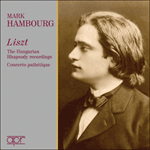 Liszt: Hungarian Rhapsodies Liszt: Hungarian RhapsodiesThe first complete survey on record, reissued for the first time.» More |
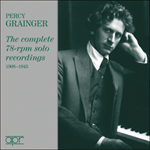 Percy Grainger - The complete 78-rpm solo recordings Percy Grainger - The complete 78-rpm solo recordings‘Here’s something a little bit special to mark the fiftieth anniversary of the death of Percy Grainger … Grainger was a charismatic pianist and a ... ‘The best of Grainger’s shellac efforts retain their vividness and communicative immediacy. Even if Grainger had never met and befriended Grieg, his i ...» More |
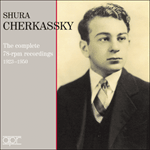 Shura Cherkassky - The complete 78-rpm recordings, 1923-1950 Shura Cherkassky - The complete 78-rpm recordings, 1923-1950In his later years, Shura Cherkassky (1909-1995) was regarded as one of the last ‘Romantics’—a throwback to the so-called ‘golden age’ of pianism in the first decades of the 20th century. As a pupil of Josef Hofmann, he had an impeccable pedigree, ...» More |
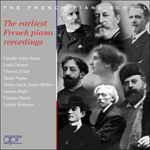 The earliest French piano recordings The earliest French piano recordingsThis set brings together some of the earliest and rarest piano recordings ever made, not just in France, but worldwide, and includes the complete solo recordings of all the pianists featured except Wurmser. The French office of the Gramophone Comp ...» More |
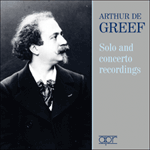 Arthur de Greef - Solo and concerto recordings Arthur de Greef - Solo and concerto recordingsBelgian pianist Arthur de Greef studied with Franz Liszt and also became a close friend of Grieg, who strongly admired his playing. He was a mainstay of the HMV catalogue in the 1920s and this set brings together for the first time his complete re ...» More |
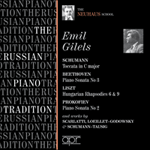 Emil Gilels - Schumann, Beethoven, Liszt & Prokofiev Emil Gilels - Schumann, Beethoven, Liszt & Prokofiev |
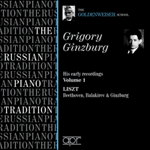 Grigory Ginzburg - His early recordings – 1 Grigory Ginzburg - His early recordings – 1'The Paganini etudes reveal a musician who marries precision with zest without taking any shortcuts pianistically; there is an honesty about his exalt ...» More |
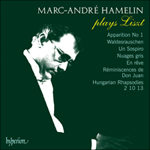 Liszt: Marc-André Hamelin plays Liszt Liszt: Marc-André Hamelin plays Liszt‘The virtuosity with which all this is despatched is exceptional’ (BBC Record Review) ‘There are few living pianists who can match him in dexterity, power and daring. For heart-thumping virtuosity Hamelin is in a class of his own’ (Clas ...» More |
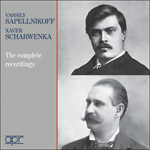 Vassily Sapellnikoff & Xaver Scharwenka - The complete recordings Vassily Sapellnikoff & Xaver Scharwenka - The complete recordingsVassily Sapellnikoff (1868–1941) and Xaver Scharwenka (1850–1924) were among the earliest generation of pianists to record, and on this ground alone it is surprising that their complete recordings have never before been transferred for modern list ...» More |
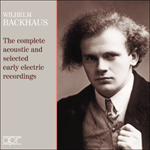 Wilhelm Backhaus - The complete acoustic and selected early electric recordings Wilhelm Backhaus - The complete acoustic and selected early electric recordingsAs one of the great pianists of the 20th century, Wilhelm Backhaus (1884-1969) needs no introduction. He recorded almost continuously from 1908 until his death, but this set, focusing on his earliest recordings, completes APR’s coverage (see also ...» More |
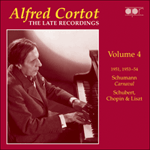 Alfred Cortot – The Late Recordings, Vol. 4 - Schumann, Schubert, Chopin & Liszt Alfred Cortot – The Late Recordings, Vol. 4 - Schumann, Schubert, Chopin & Liszt'Bryan Crimp has done Cortot proud, prompting one to wonder whether there was ever a pianist of greater human richness and coruscating vitality' (Gram ...» More |
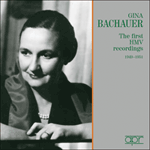 Gina Bachauer - The first HMV recordings Gina Bachauer - The first HMV recordings'Here is a noble tribute to a noble pianist. Gina Bachauer (1913-76) was an artist whose exultant virtuosity and unswerving musical honesty became one ...» More |
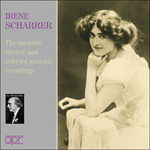 Irene Scharrer - The complete electric and selected acoustic recordings Irene Scharrer - The complete electric and selected acoustic recordings‘If [Irene Scharrer]'s remembered from her recordings it’s really only the one, and that was ironically the last she made, Litolff’s Scherzo from the ...» More |
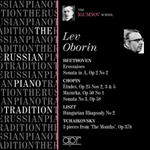 Lev Oborin - Beethoven, Chopin & Liszt Lev Oborin - Beethoven, Chopin & Liszt Classical Music» More Classical Music» More |
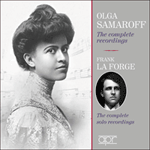 Olga Samaroff & Frank La Forge - The complete recordings Olga Samaroff & Frank La Forge - The complete recordingsOlga Samaroff and Frank La Forge were amongst the earliest pianists to record for the US Victor label, both making most of their discs in the acoustic era before 1925. Samaroff was the greater virtuoso, as can be heard in her famous recording of W ...» More |
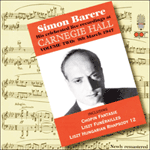 Simon Barere – His celebrated live recordings at Carnegie Hall, Vol. 2 - 9 March 1947 Simon Barere – His celebrated live recordings at Carnegie Hall, Vol. 2 - 9 March 1947 |
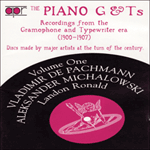 The Piano G & Ts, Vol. 1 - Vladimir de Pachmann, Aleksander Michalowski & Landon Ronald The Piano G & Ts, Vol. 1 - Vladimir de Pachmann, Aleksander Michalowski & Landon Ronald |
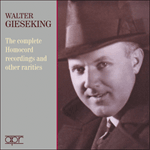 Walter Gieseking - The complete Homocord recordings and other rarities Walter Gieseking - The complete Homocord recordings and other raritiesWalter Gieseking is known as one of the greatest 20th-century pianists, and his playing of Debussy and Ravel in particular is often regarded as definitive. For most of his recording career he recorded for Columbia, but his earliest recordings were ...» More |
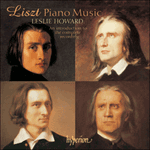 Liszt: Piano Music Liszt: Piano Music |

